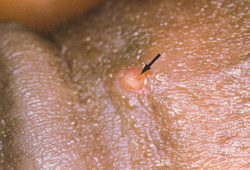Resumo
Definição
História e exame físico
Principais fatores diagnósticos
- presença de fatores de risco
- linfadenopatia inguinal
- sintomas inespecíficos de proctocolite
- sinal de sulco de Greenblatt
- elefantíase genital, pênis saxofone, estiomene
Outros fatores diagnósticos
- febre, mal-estar, artralgias
- dor na parte inferior do abdome ou lombalgia
- úlcera genital ou anal
- sintomas inespecíficos de disseminação bacterêmica
- eritema nodoso
- tratos sinusais anogenitais, estenoses ou fístulas
Fatores de risco
- outras ISTs
- comportamento sexual de risco
- soropositividade do vírus da imunodeficiência humana (HIV)
- idade (entre 20 e 40 anos)
- relação sexual sem proteção em uma área endêmica para LGV
- sexo masculino
Investigações diagnósticas
Primeiras investigações a serem solicitadas
- amostras genitais ou de linfonodos para o teste de amplificação de ácido nucleico (NAAT)
- swab via anoscopia para coloração de Gram
- fluido ou swab para testes moleculares específicos para LGV
- Testes para IST
Investigações a serem consideradas
- endoscopia com histopatologia
- soro para fixação de complemento
- soro para microimunofluorescência (MIF)
- tomografia computadorizada (TC) do abdome e pelve
- ressonância nuclear magnética (RNM) do abdome e pelve
- fluido ou swab para cultura
Novos exames
- fluido ou swab para tipagem da variante genômica
Algoritmo de tratamento
adolescentes assintomáticos e pacientes adultos que tenham sido expostos a linfogranuloma venéreo (LGV)
todos os estágios do linfogranuloma venéreo (LGV)
Colaboradores
Autores
Benjamin D. Lorenz, MD
Assistant Professor
Division of Hospital Medicine
MedStar Georgetown University Hospital
Washington
DC
Declarações
BDL declares that he has no competing interests.
Agradecimentos
Dr Benjamin D. Lorenz would like to gratefully acknowledge Dr Mettassebia Kanno, a previous contributor to this topic.
Declarações
MK declares that she has no competing interests.
Revisores
Cees van Nieuwkoop, MD
Department of General Internal Medicine
Leiden University Medical Centre
Leiden
The Netherlands
Declarações
CvN declares that he has no competing interests.
David Chelmow, MD
Chair
Department of Obstetrics and Gynecology
Virginia Commonwealth University
Richmond
VA
Declarações
DC declares that he has no competing interests.
Créditos aos pareceristas
Os tópicos do BMJ Best Practice são constantemente atualizados, seguindo os desenvolvimentos das evidências e das diretrizes. Os pareceristas aqui listados revisaram o conteúdo pelo menos uma vez durante a história do tópico.
Declarações
As afiliações e declarações dos pareceristas referem--se ao momento da revisão.
Referências
Principais artigos
de Vries HJC, de Barbeyrac B, de Vrieze NHN, et al. 2019 European guideline on the management of lymphogranuloma venereum. J Eur Acad Dermatol Venereol. 2019 Jun 26;33(10):1821-8.Texto completo Resumo
Centers for Disease Control and Prevention. Lymphogranuloma venereum among men who have sex with men - Netherlands, 2003-2004. MMWR Morb Mortal Wkly Rep. 2004 Oct 29;53(42):985-8.Texto completo Resumo
Van der Bij AK, Spaargaren J, Morre SA, et al. Diagnostic and clinical implications of anorectal lymphogranuloma venereum in men who have sex with men: a retrospective case-control study. Clin Infect Dis. 2006 Jan 15;42(2):186-94.Texto completo Resumo
Stamm WE. Lymphogranuloma venereum. In: Holmes KK, Sparling PF, Stamm WE, et al., eds. Sexually transmitted diseases. 4th ed. New York, NY: McGraw Hill; 2007:595-606.
Workowski KA, Bachmann LH, Chan PA, et al. Sexually transmitted infections treatment guidelines, 2021. MMWR Recomm Rep. 2021 Jul 23;70(4):1-187.Texto completo Resumo
Mabey D, Peeling RW. Lymphogranuloma venereum. Sex Transm Infect. 2002 Apr;78(2):90-2.Texto completo Resumo
Thorsteinsson SB. Lymphogranuloma venereum: review of clinical manifestations, epidemiology, diagnosis, and treatment. Scand J Infect Dis Suppl. 1982;32:127-31. Resumo
Annamuthodo H. Rectal lymphogranuloma venereum in Jamaica. Ann R Coll Surg Engl. 1961 Sep;29:141-59.Texto completo Resumo
Artigos de referência
Uma lista completa das fontes referenciadas neste tópico está disponível para os usuários com acesso total ao BMJ Best Practice.

Diagnósticos diferenciais
- Sífilis (Treponema pallidum)
- Proctite gonocócica
- Herpes genital (HSV)
Mais Diagnósticos diferenciaisDiretrizes
- BASHH summary guidance on testing for sexually transmitted infections, 2023
- Sexually transmitted infections treatment guidelines, 2021
Mais DiretrizesFolhetos informativos para os pacientes
Clamídia
Mais Folhetos informativos para os pacientesConectar-se ou assinar para acessar todo o BMJ Best Practice
O uso deste conteúdo está sujeito ao nosso aviso legal